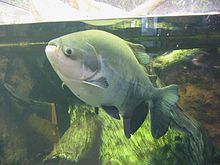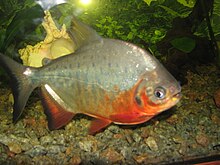
The Amazon river dolphin, also known as the boto, bufeo or pink river dolphin, is a species of toothed whale endemic to South America and is classified in the family Iniidae. Three subspecies are currently recognized: I. g. geoffrensis, I. g. boliviensis and I. g. humboldtiana while position of Araguaian river dolphin within the clade is still unclear. The three subspecies are distributed in the Amazon basin, the upper Madeira River in Bolivia, and the Orinoco basin, respectively.
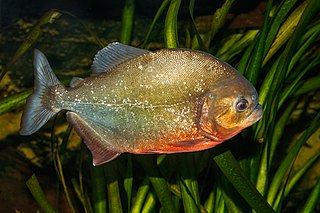
A piranha or piraña is any of a number of freshwater fish species in the family Serrasalmidae, or the subfamily Serrasalminae within the tetra family, Characidae in order Characiformes. These fish inhabit South American rivers, floodplains, lakes and reservoirs. Although often described as extremely predatory and mainly feeding on fish, their dietary habits vary extensively, and they will also take plant material, leading to their classification as omnivorous.

The arapaima, pirarucu, or paiche is any large species of bonytongue in the genus Arapaima native to the Amazon and Essequibo basins of South America. Arapaima is the type genus of the subfamily Arapaiminae within the family Osteoglossidae. They are among the world's largest freshwater fish, reaching as much as 3 m (9.8 ft) in length. They are an important food fish. They have declined in the native range due to overfishing and habitat loss. In contrast, arapaima have been introduced to several tropical regions outside the native range, where they are sometimes considered invasive species. In Kerala, India, arapaima escaped from aquaculture ponds after floods in 2018. Its Portuguese name, pirarucu, derives from the Tupi language words pira and urucum, meaning "red fish".

Peacock bass or Brazilian tucunaré are large freshwater cichlids of the genus Cichla. These are diurnal predatory fishes native to the Amazon and Orinoco basins, as well as rivers of the Guianas, in tropical South America. They are sometimes referred to in English by their Brazilian name tucunaré or their Spanish name pavon. Despite the common name and their superficial similarity, they are not closely related to other fish known as bass, such as the North American largemouth bass.

The Mekong giant catfish, is a large, threatened species of catfish in the shark catfish family (Pangasiidae), native to the Mekong basin in Southeast Asia and adjacent China. It is considered critically endangered due to overfishing and habitat loss.

Piaractus mesopotamicus, the small-scaled pacu, Paraná River pacu or simply pacu, is a South American ray-finned fish that is native to the Paraguay-Paraná River basin, but it has been introduced by aquaculture activities in a wider area. In its native range it is also known as the pacú chato, pez chato or mbiraí-piraí.

The Sampit River begins in a swampy area of western Georgetown County, South Carolina, USA. It flows in an easterly direction to Winyah Bay at Georgetown. Only small crafts can navigate the upper parts of the river. The lower river merges into the bay and is deepened by tidal flows, and by dredging.

The redtail catfish, Phractocephalus hemioliopterus, is a pimelodid (long-whiskered) catfish. In Venezuela, it is known as cajaro, in Guyana, it is known as a banana catfish, and in Brazil, it is known as pirarara, stemming from the Tupi language words pirá and arara. It is the only extant species of the genus Phractocephalus. This fish is common in the aquarium trade, although its massive adult size makes it unsuitable for all but the largest aquariums. They feed on fish, crustaceans and fallen fruits. They are not evaluated by IUCN.
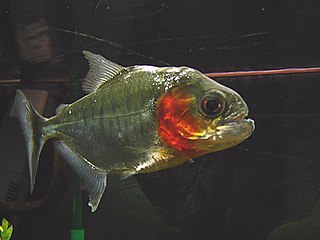
The Serrasalmidae (serrasalmids) are a family of characiform fishes, recently elevated to family status. It includes more than 90 species. The name means "serrated salmon family", which refers to the serrated keel running along the belly of these fish. Fish classified as Serrasalmidae are also known by these common names: pacu, piranha, and silver dollar. These common names generally designate differing dental characteristics and feeding habits.

The red-bellied piranha, also known as the red piranha, is a type of piranha native to South America, found in the Amazon, Paraguay, Paraná and Essequibo basins, as well as coastal rivers of northeastern Brazil. This fish is locally abundant in its freshwater habitat. They are omnivorous foragers and feed on insects, worms, crustaceans, and fish. They are not a migratory species but do travel to seek out conditions conducive to breeding and spawning during periods of increased rainfall. Red-bellied piranhas often travel in shoals as a predatory defense but rarely exhibit group hunting behavior. Acoustic communication is common and is sometimes exhibited along with aggressive behaviors. They are a popular aquarium fish.

The tambaqui is a large species of freshwater fish in the family Serrasalmidae. It is native to tropical South America, but kept in aquaculture and introduced elsewhere. It is also known by the names black pacu, black-finned pacu, giant pacu, cachama, gamitana, and sometimes as pacu.

Piaractus brachypomus, the pirapitinga, is a large species of pacu, a close relative of piranhas and silver dollars, in the serrasalmid family. It is native to the Amazon basin in tropical South America, but it formerly included populations in the Orinoco, which was described in 2019 as a separate species, P. orinoquensis. Additionally, P. brachypomus is widely farmed and has been introduced to other regions. In South Florida they are invasive in rivers, canals or lakes.

Carp is a common name for various species of freshwater fish from the family Cyprinidae that are native to Eurasia and sought after by some recreational fishermen. Certain carp species have been introduced, with mixed results, to various other locations around the world, and even declared invasive in certain regions.

Megapiranha is an extinct serrasalmid characin fish from the Late Miocene Ituzaingó Formation of Argentina, described in 2009. The type species is M. paranensis. It is thought to have been about 71 centimetres (28 in) in length and 10 kilograms (22 lb) in weight. The holotype consists only of premaxillae and a zigzag tooth row; the rest of its body is unknown. This dentition is reminiscent of both the double-row seen in pacus, and the single row seen in the teeth of modern piranhas, suggesting that M. paranensis is a transitional form. Its bite force is estimated between 1,240–4,749 N (279–1,068 lbf).

Mylossoma is a genus of serrasalmids from tropical and subtropical South America, including the basins of the Amazon, Orinoco, Lake Maracaibo and Paraguay-Paraná. These common fish are found both in main river sections and floodplains. They support important fisheries and based on a review by IBAMA, they are the seventh most caught fish by weight in the Brazilian Amazon. They primarily feed on plant material such as seeds and fruits, and in their ecology they generally resemble the larger tambaqui. Mylossoma reach up to 28.5 cm (11.2 in) in length and 1 kg (2.2 lb) in weight.

Piaractus is a genus of large serrasalmid from South America. The two traditionally recognized species of Piaractus are very similar in appearance and were formerly included in the genus Colossoma, which currently only contains another similar species, the tambaqui. A third Piaractus was described in 2019 as a new species, but it was formerly considered a subpopulation of P. brachypomus.
Red-bellied pacu can refer to the following species of fish of the subfamily Serrasalminae:
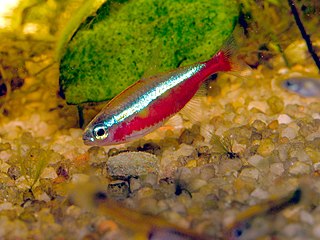
Project Piaba is a fishery initiative located on the Rio Negro tributary of the Amazon River. The program both promotes and researches sustainable aquarium pet fish collection and its impact on the environment. The name of the project comes from the Brazilian Portuguese word, piaba, which means "little fish", referring specifically to the cardinal tetra. Project Piaba is an ongoing project with annual research expeditions to the Rio Negro region. Because of the sustainable nature of the project, its slogan is "Buy a Fish, Save a Tree!"
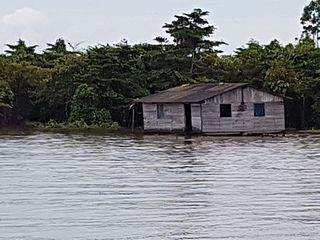
The Gurupa várzea (NT0126) is an ecoregion of seasonally and tidally flooded várzea forest along the Amazon River in the Amazon biome.

The Purus várzea (NT0156) is an ecoregion of seasonally flooded várzea forest in the central Amazon basin. It is part of the Amazon biome. The ecoregion is home to a vegetation adapted to floods of up to 12 metres (39 ft) that may last for eight months. There is a great variety of fish and birds, but relatively fewer mammals. Ground-dwelling mammals must migrate to higher ground during the flood season. Threats include logging, cattle farming, over-fishing and mercury pollution from gold mining.
